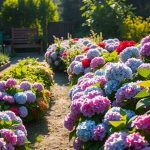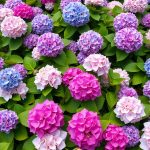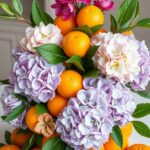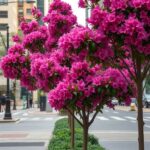I absolutely love how a garden filled with lavender and hydrangeas instantly creates a dreamy, serene vibe. The mix of soft purple blooms, lush greenery, and those full, round hydrangea blossoms feels like stepping into a storybook. I can’t get enough of the way these plants add both color and texture to any outdoor space.
Lavender brings a gentle, calming scent and a touch of elegance, while hydrangeas offer that bold, show-stopping look that draws the eye. Together, they make a garden feel romantic, inviting, and effortlessly beautiful. Even just a small corner of your yard can feel like a peaceful retreat when these plants are incorporated thoughtfully.
If you’re ready to bring this charm to your own garden, I’ve rounded up some gorgeous lavender and hydrangea options you can add today. These picks are perfect for planting or arranging in pots to create a stunning outdoor scene.





Picture yourself wandering through a garden where clusters of fragrant lavender sway gently in the breeze, and voluminous hydrangea blooms pop against the greenery. The colors, textures, and soothing scents make every step feel like a mini escape, whether you’re enjoying your morning coffee or hosting friends for an afternoon garden party.
Now let’s explore 21+ inspiring ways to use lavender and hydrangeas in your landscaping so your garden feels lush, vibrant, and truly magical.
Combining Lavender and Hydrangeas for Contrast
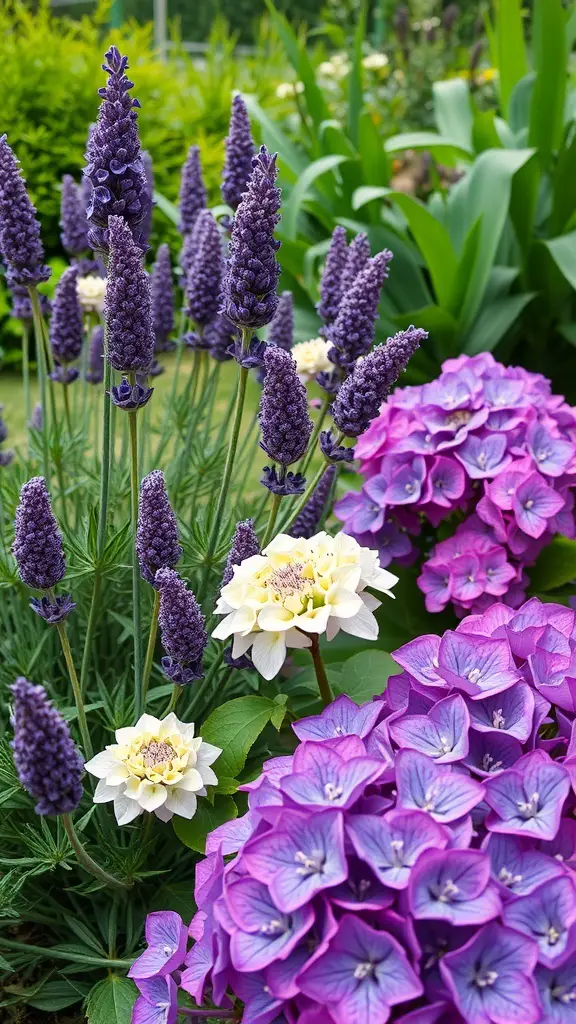
Lavender and hydrangeas make a stunning pair in any garden. The vibrant purple of lavender contrasts beautifully with the soft hues of hydrangeas. This combination creates a lively yet calming atmosphere.
Lavender’s tall, spiky flowers add height and texture, while hydrangeas provide a lush, rounded shape. Planting them together can enhance the visual appeal of your landscape. Consider mixing different shades of hydrangeas to add depth and interest.
When designing your space, think about the placement. Lavender thrives in sunny spots, while hydrangeas can tolerate partial shade. This means you can create layers in your garden, with lavender standing tall in the front and hydrangeas filling the background.
Don’t forget to consider the scents! Lavender offers a delightful fragrance that can attract pollinators. This not only enhances the beauty of your garden but also supports local wildlife.
The Benefits of Lavender in Landscaping
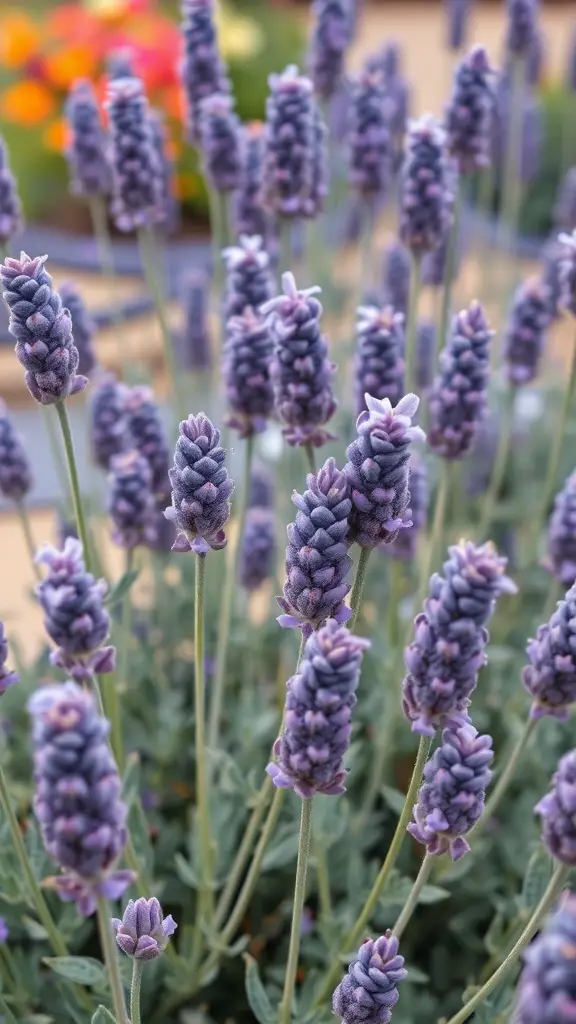
Lavender is a stunning addition to any garden. Its tall, purple spikes create a beautiful contrast against green foliage. The vibrant color not only catches the eye but also brings a sense of calm to outdoor spaces.
One of the best things about lavender is its delightful fragrance. The scent can transform your garden into a relaxing retreat. It’s perfect for creating a peaceful atmosphere where you can unwind after a long day.
Lavender is also a magnet for pollinators. Bees and butterflies are drawn to its flowers, making it a great choice for anyone looking to support local wildlife. This adds life to your garden and helps with the pollination of other plants.
Another benefit is that lavender is drought-resistant. Once established, it requires minimal watering. This makes it a practical choice for those who want a beautiful garden without the hassle of constant maintenance.
Lastly, lavender can be used in cooking and crafts. Its flowers can be harvested for culinary uses or dried for sachets. This versatility makes it a valuable plant in any landscape design.
Hydrangea Varieties for Colorful Borders
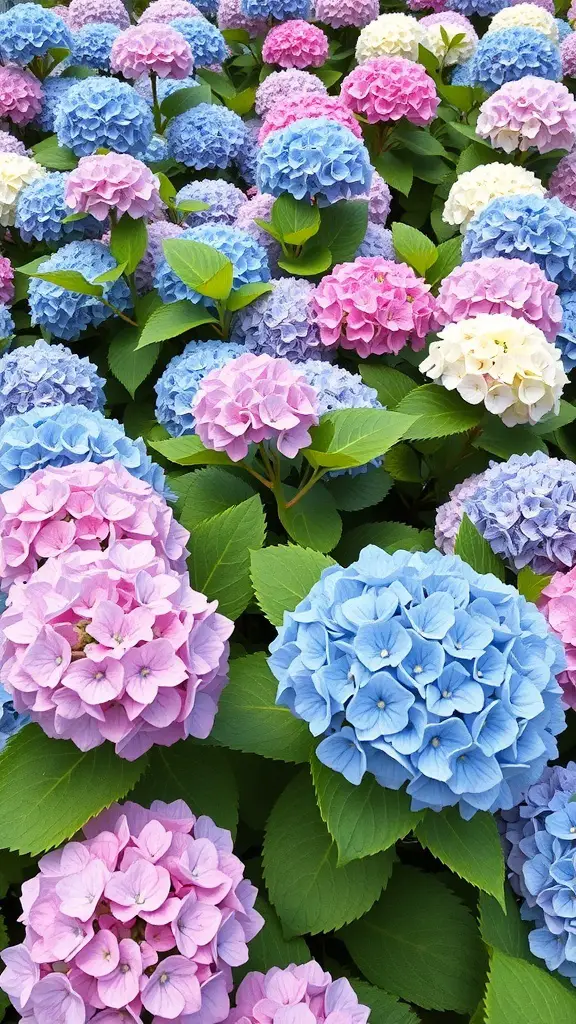
Hydrangeas are a fantastic choice for adding color to your garden. They come in various shades, making them perfect for borders. The image showcases a vibrant mix of blue, pink, and white hydrangeas, creating a stunning visual effect.
These flowers bloom in clusters, offering a lush appearance. You can plant different varieties together to create a beautiful gradient of colors. For instance, pairing blue and pink hydrangeas can create a lovely contrast that catches the eye.
When selecting hydrangeas for your borders, consider their growth habits. Some varieties are compact, while others can grow quite large. This diversity allows you to design your garden layout based on your space and style.
Hydrangeas thrive in well-drained soil and prefer partial shade, making them suitable for various garden settings. With the right care, they can bloom beautifully year after year, providing a colorful backdrop to your outdoor space.
Creating a Serene Lavender Pathway
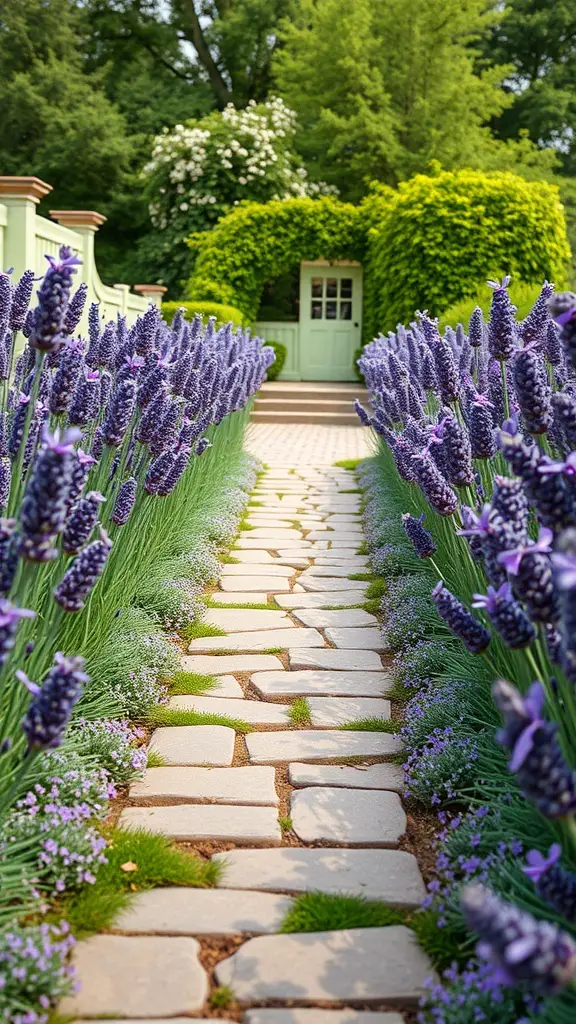
A lavender pathway can transform any garden into a peaceful retreat. The vibrant purple hues and soothing scents create a calming atmosphere. Imagine walking down a stone path lined with lush lavender plants, their fragrance filling the air.
To create this serene space, start by choosing a suitable location. Look for a spot that gets plenty of sunlight, as lavender thrives in bright conditions. Prepare the soil by ensuring it drains well, as lavender doesn’t like to sit in water.
Next, plant your lavender in neat rows along the pathway. This not only enhances the visual appeal but also makes maintenance easier. Consider mixing in some low-growing flowers or ground cover plants for added texture and color.
Finally, add stepping stones or pavers to form a clear path. This will guide visitors through your garden while keeping the focus on the beautiful lavender. A serene lavender pathway invites relaxation and enjoyment, making it a perfect addition to any outdoor space.
Hydrangeas as Focal Points in Garden Design
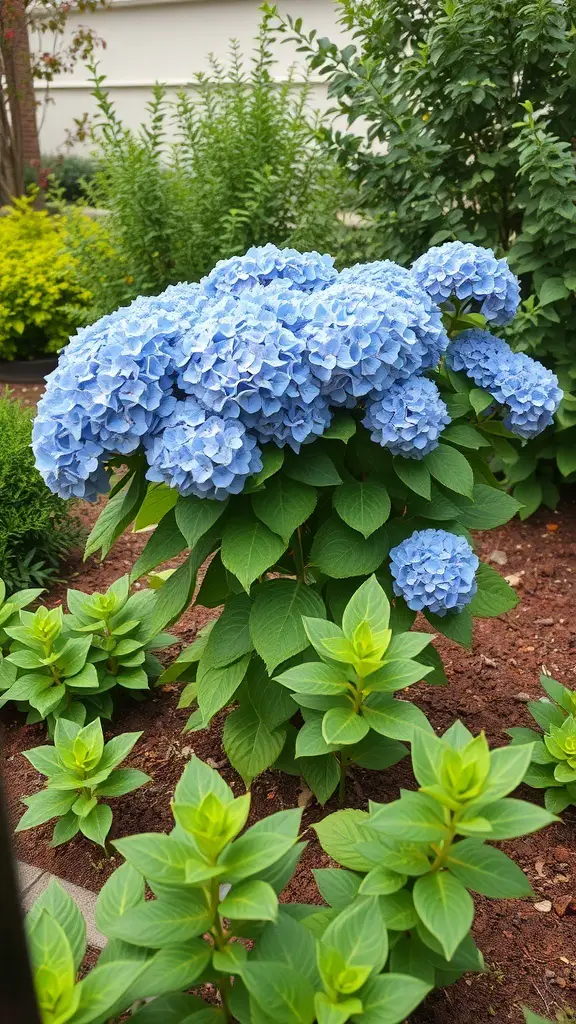
Hydrangeas are stunning plants that can easily become the stars of any garden. Their large, colorful blooms draw the eye and create a sense of joy. In the image, you can see a beautiful cluster of blue hydrangeas surrounded by fresh green foliage. This combination not only adds color but also texture to the landscape.
Using hydrangeas as focal points can transform a simple garden into a vibrant space. They work well in various settings, whether in a cozy backyard or a more expansive garden. The way they stand tall and proud makes them perfect for drawing attention.
When planning your garden, think about where to place hydrangeas. Position them where they can be easily seen, perhaps near a pathway or at the center of a flower bed. Their lush blooms can complement other plants, especially when paired with lavender, which adds a lovely contrast.
Overall, hydrangeas can bring life and beauty to your garden design. Their bold colors and shapes make them a fantastic choice for anyone looking to create a stunning outdoor space.
Designing a Lavender and Hydrangea Garden Bed
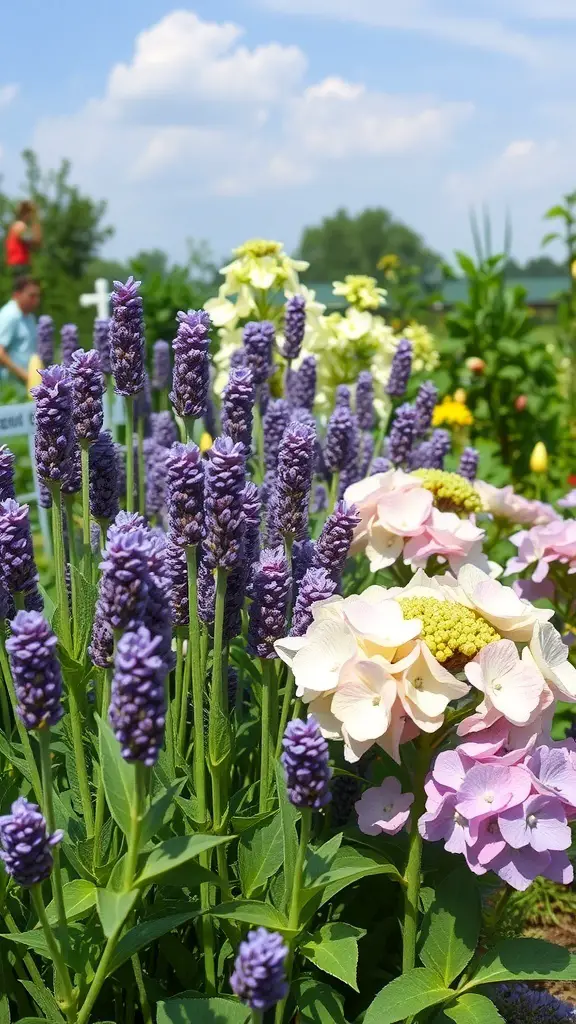
Creating a garden bed with lavender and hydrangea can be a delightful project. These two plants complement each other beautifully, offering a mix of colors and scents. Lavender brings a lovely purple hue and a calming fragrance, while hydrangeas add soft pinks and whites, creating a stunning visual contrast.
When planning your garden bed, consider the layout. Place lavender in the front or along the edges, as it tends to grow lower. This allows the taller hydrangeas to stand out behind them. Think about the spacing too; give each plant enough room to thrive without overcrowding.
Soil quality is key. Both plants prefer well-drained soil, so adding compost can help improve drainage and nutrients. Watering is essential, especially during dry spells. Lavender is drought-tolerant, but hydrangeas will need regular moisture to keep their blooms vibrant.
Lastly, don’t forget about sunlight. Both plants thrive in full sun, so choose a spot that gets plenty of light throughout the day. With a little planning and care, your lavender and hydrangea garden bed will flourish and become a beautiful focal point in your outdoor space.
Creating a Lavender Herb Garden
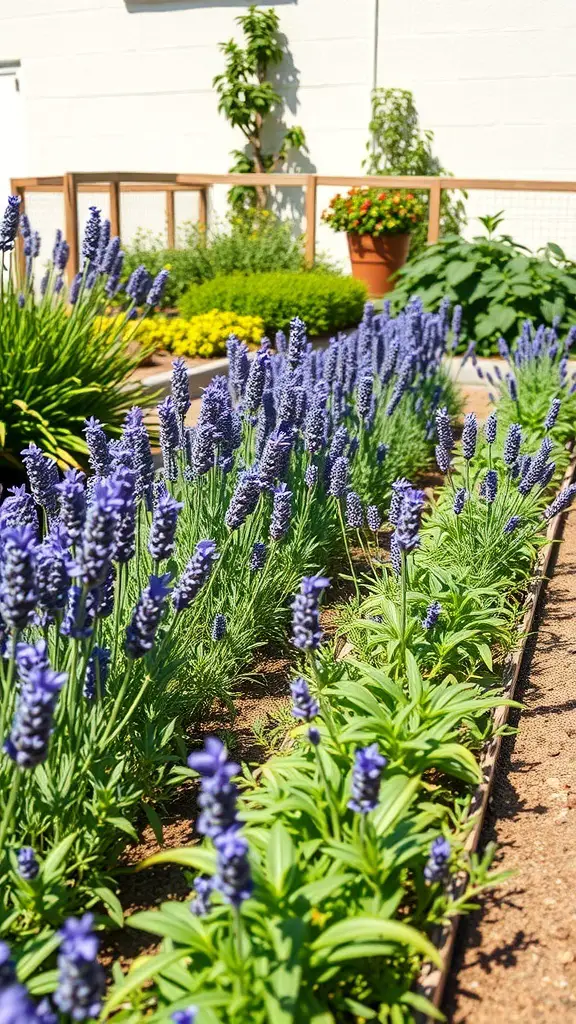
Lavender is a fantastic choice for any herb garden. Its vibrant purple flowers and delightful fragrance can brighten up any space. In the image, you can see a beautiful arrangement of lavender plants, neatly lined up and thriving in the sunlight. This setup not only looks great but also offers a wonderful aroma.
When planning your lavender garden, think about the layout. You can create rows of lavender, as shown, or mix them with other herbs for a colorful display. Lavender pairs well with herbs like rosemary and thyme, adding both beauty and functionality to your garden.
Consider the growing conditions for lavender. They thrive in well-drained soil and full sun. Make sure to water them properly, especially during dry spells. Once established, they require less water, making them a low-maintenance option.
Harvesting lavender is easy and rewarding. You can cut the stems when the flowers are in full bloom. This not only encourages new growth but also allows you to use the lavender in various ways, such as in sachets or culinary dishes.
Seasonal Care for Lavender and Hydrangeas
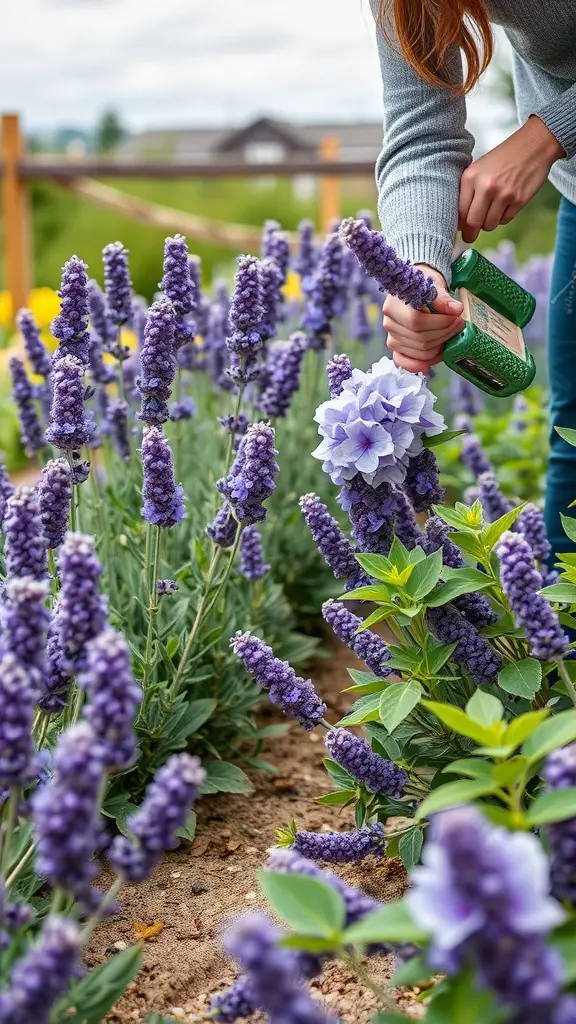
Taking care of lavender and hydrangeas throughout the seasons can keep your garden looking vibrant and healthy. Lavender thrives in sunny spots with well-drained soil. During spring, it’s a good idea to prune back any dead stems. This encourages new growth and keeps the plant bushy.
Hydrangeas, on the other hand, need a bit more attention. In early spring, check for any dead or damaged branches and trim them away. This helps the plant focus its energy on producing beautiful blooms. Remember to water them regularly, especially during dry spells.
As summer rolls in, lavender will need less water, while hydrangeas may require more. Keep an eye on the soil moisture. In the fall, both plants benefit from a light pruning to prepare them for winter. Mulching around the base can help protect the roots from frost.
In winter, lavender can handle the cold, but hydrangeas might need some extra care. Cover them with mulch or burlap to shield them from harsh weather. With a little seasonal care, your lavender and hydrangeas will thrive beautifully in your garden.
Hydrangeas in Shade vs. Sun
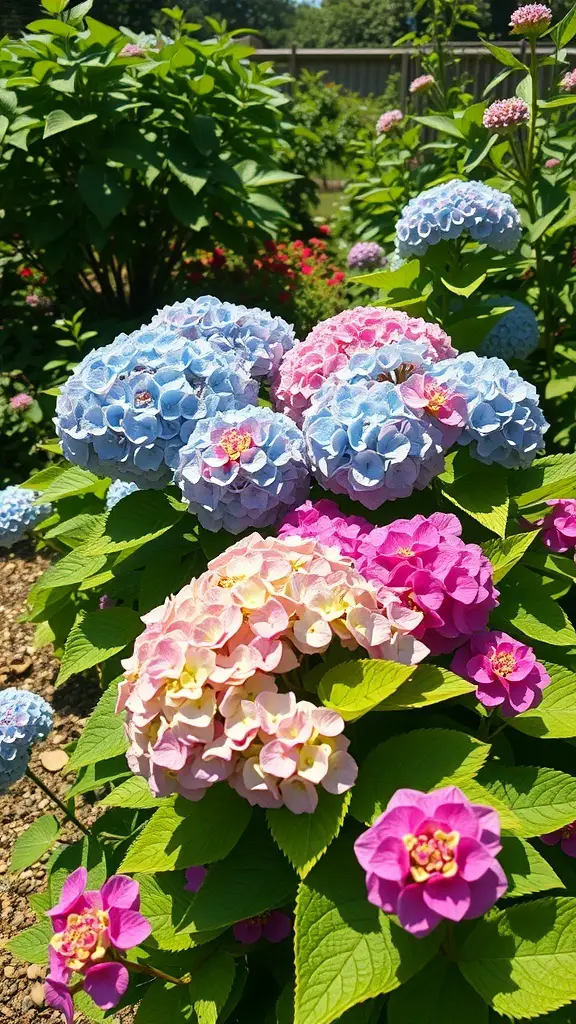
Hydrangeas are stunning flowers that can thrive in different light conditions. When it comes to shade versus sun, the choice can significantly affect their growth and appearance.
In sunny spots, hydrangeas often produce vibrant blooms. They soak up the sunlight, which helps them develop rich colors. However, too much sun can lead to wilting or burnt leaves, especially in hotter climates.
On the flip side, hydrangeas in shaded areas may not bloom as profusely, but they can still thrive. The cooler temperatures help maintain moisture, which is essential for their health. These plants can offer a softer, more muted color palette, creating a serene garden vibe.
So, whether you have a sun-drenched garden or a cozy shaded nook, hydrangeas can adapt beautifully. Just keep an eye on their needs, and you’ll enjoy their charm all season long!
Lavender and Hydrangea in Container Gardening
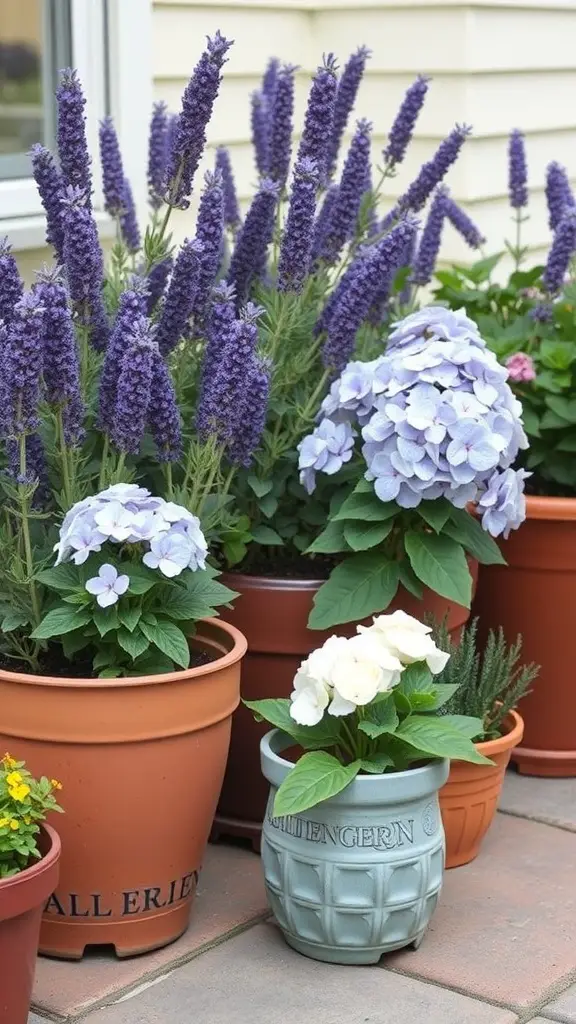
Container gardening with lavender and hydrangea brings a splash of color and fragrance to any space. These plants thrive in pots, making them perfect for patios, balconies, or small gardens.
The vibrant purple of lavender contrasts beautifully with the soft blues and whites of hydrangeas. This combination not only looks stunning but also attracts pollinators like bees and butterflies.
When choosing pots, consider varying sizes and styles to create visual interest. Terracotta pots work well for lavender, as they allow for good drainage. Hydrangeas can thrive in decorative containers that hold moisture.
Ensure both plants receive adequate sunlight and water. Lavender prefers well-drained soil, while hydrangeas enjoy a bit more moisture. Regular pruning helps maintain their shape and encourages more blooms.
Mixing in other plants, like small herbs or colorful annuals, can enhance the overall look. This creates a lively and inviting atmosphere in your outdoor space.
Incorporating Lavender into Xeriscaping
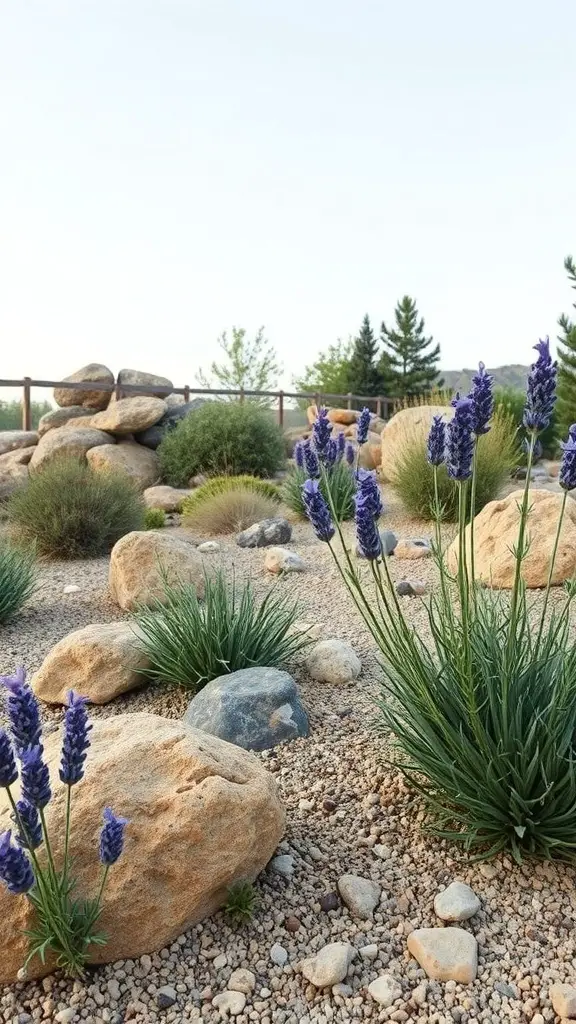
Lavender is a fantastic choice for xeriscaping, thanks to its drought-resistant qualities. The image shows vibrant lavender plants nestled among rocks and gravel, creating a beautiful and low-maintenance landscape. This setup not only looks great but also conserves water.
When planning your xeriscape, think about grouping lavender with other drought-tolerant plants. This can create a stunning visual contrast and enhance the overall design. The purple hues of lavender can brighten up any space, making it a favorite among gardeners.
Consider planting lavender near pathways or seating areas. The fragrance can add a delightful sensory experience to your outdoor space. Plus, lavender attracts pollinators like bees and butterflies, which can help your garden thrive.
To maintain your lavender, ensure it has well-draining soil and plenty of sunlight. This will keep the plants healthy and blooming throughout the growing season. With the right care, your lavender can flourish and become a standout feature in your xeriscape.
Designing a Pollinator-Friendly Landscape
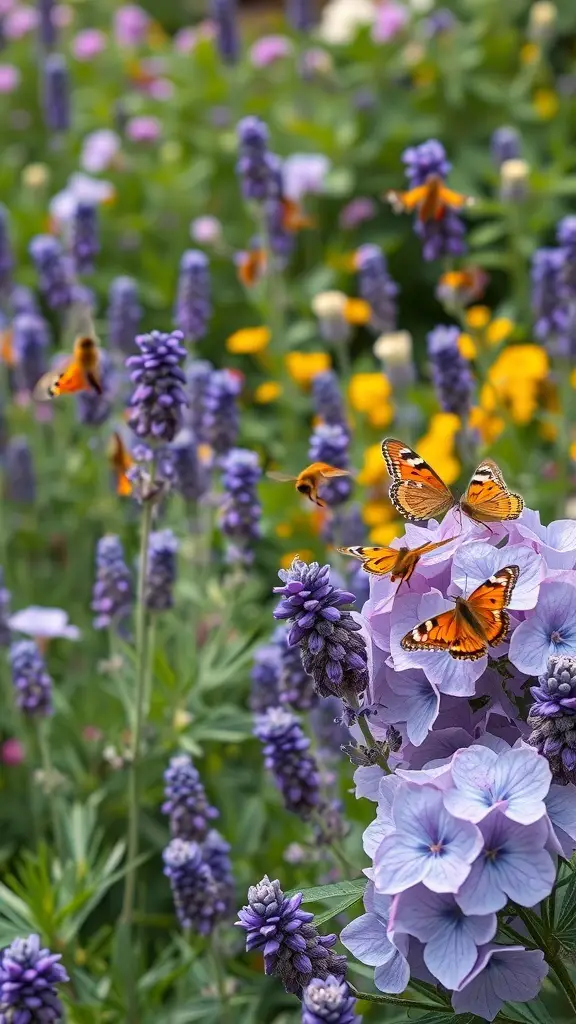
Creating a pollinator-friendly landscape is a rewarding way to support local wildlife. Imagine a garden filled with vibrant lavender and hydrangea, where butterflies flutter and bees buzz. These flowers not only look beautiful but also attract a variety of pollinators.
Lavender is a fantastic choice. Its fragrant blooms are irresistible to bees, making it a perfect addition to any garden. Plus, it thrives in sunny spots and requires minimal care. Hydrangeas, with their large, colorful clusters, provide a striking contrast. They offer nectar for butterflies and other pollinators, enhancing the visual appeal of your space.
Mixing these two plants creates a lively scene. The soft purples of lavender paired with the bold hues of hydrangeas can turn your yard into a colorful haven. Consider planting them in clusters to create a more inviting atmosphere for pollinators.
Adding other native plants can further enhance your garden. Look for flowers that bloom at different times to provide food throughout the seasons. This diversity will keep your garden buzzing with activity all year long.
Creating a Lavender-Scented Oasis
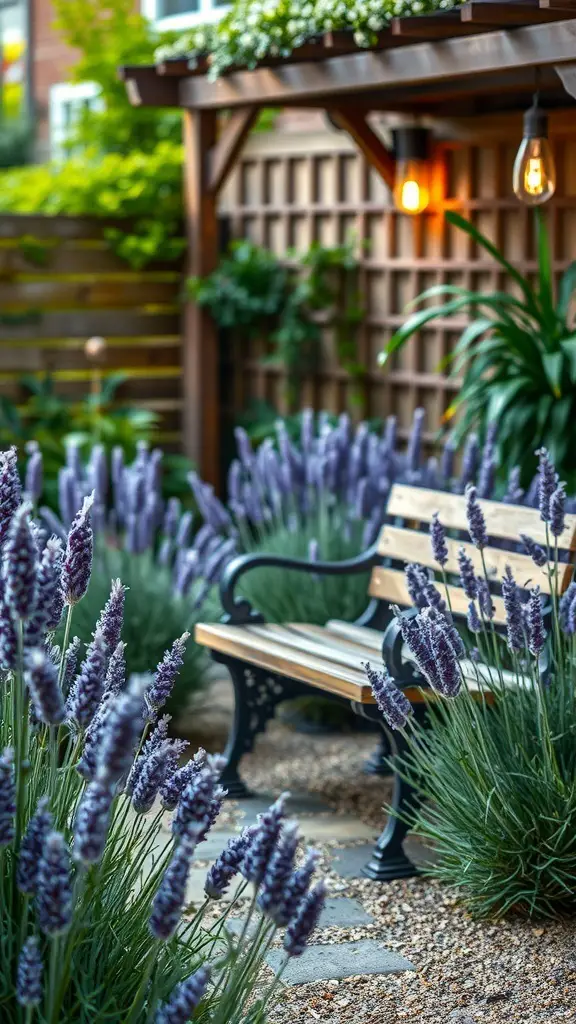
Imagine stepping into a space filled with the calming scent of lavender. This garden scene showcases a beautiful arrangement of lavender plants, creating a serene atmosphere. The soft purple hues of the flowers contrast nicely with the earthy tones of the gravel path and the wooden bench.
The bench invites you to sit back and enjoy the tranquility. It’s a perfect spot for reading a book or sipping tea while surrounded by nature. The gentle sway of the lavender in the breeze adds to the peaceful vibe.
Adding hydrangeas nearby can enhance this lavender oasis. Their lush blooms can provide a stunning backdrop, making the space even more inviting. Consider planting them in clusters to create a colorful contrast with the lavender.
Lighting is also key. The warm glow from the hanging lights adds a cozy touch, making this garden a lovely place to unwind in the evening. With a few decorative elements, like garden art or cozy throws, you can transform this area into your personal retreat.
Using Lavender for Natural Pest Control
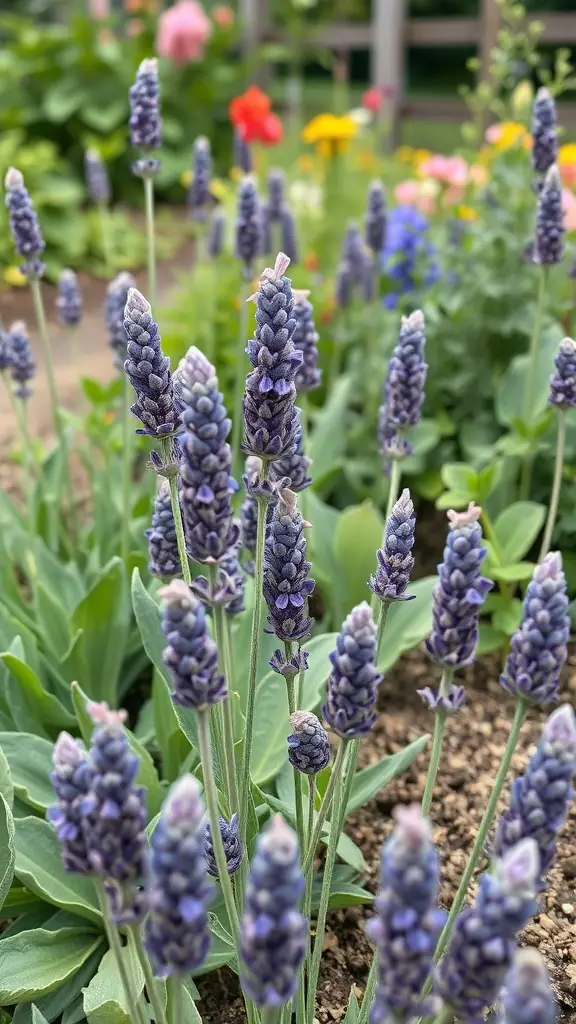
Lavender is not just a pretty flower; it’s a natural pest repellent. The image shows vibrant lavender plants standing tall, their purple blooms attracting attention. These plants are known for their lovely scent, which is pleasing to humans but off-putting to many pests.
When planted in your garden, lavender can help keep away unwanted insects like mosquitoes, flies, and moths. The aroma released by lavender can confuse these pests, making it harder for them to find their way. This means you can enjoy your outdoor space without the annoyance of bugs buzzing around.
Besides pest control, lavender adds beauty to your landscaping. Its tall spikes of purple flowers create a stunning contrast against green foliage. Pairing lavender with hydrangeas can enhance the overall look of your garden, making it both functional and visually appealing.
To maximize its pest-repelling properties, consider planting lavender near entry points or areas where you notice a lot of insect activity. This simple addition can create a more enjoyable outdoor experience.
Hydrangea Color Changing Techniques
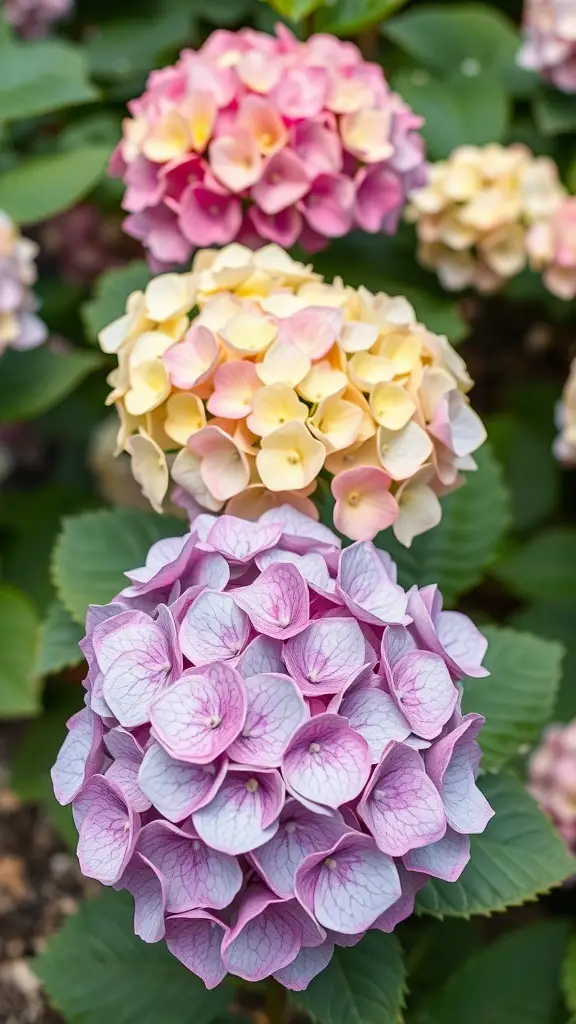
Hydrangeas are known for their stunning blooms that can change color based on soil conditions. This image showcases a beautiful array of hydrangeas in shades of pink, yellow, and lavender. Each flower head is unique, reflecting the plant’s ability to adapt to its environment.
To achieve different colors, gardeners often adjust the soil’s pH. For blue blooms, acidic soil is key, while alkaline conditions can lead to pink flowers. Yellow hues can emerge in neutral soils, creating a lovely gradient effect.
Another fun technique is using aluminum sulfate. This compound can help shift the color towards blue when added to the soil. Regular monitoring of soil pH can help maintain the desired color throughout the growing season.
Mixing in organic matter, like compost, can also influence color and improve overall plant health. Experimenting with these techniques can lead to a vibrant display that enhances any garden.
